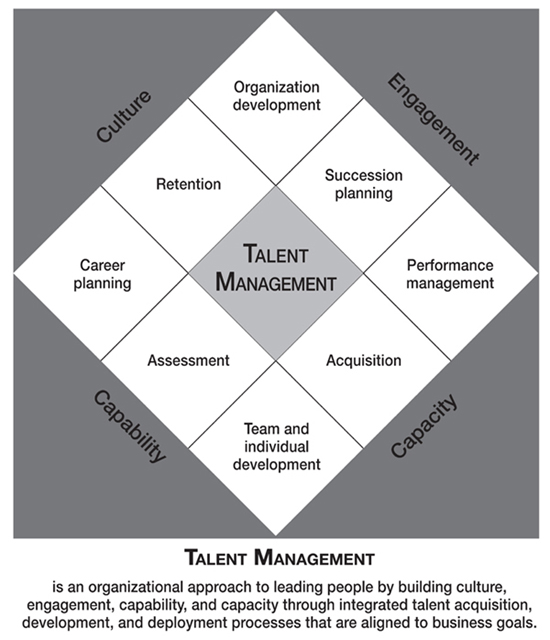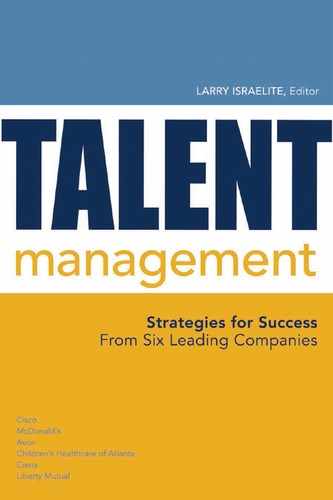Appendix: The New Face of
Talent Management
Note: The following is a slightly revised version of the Executive Summary of the ASTD white paper The New Face of Talent Management: Making Sure that People Really Are Your Most Important Asset, (2009b). To download a digital file of the complete paper, go to www.astd. org and type “talent management white paper” in the search box.
For companies that are truly competitors in the knowledge economy, what was good enough performance yesterday is rarely good enough today—and will almost never be good enough tomorrow. For most organizations, the best way to meet this challenge is to become human-capital-centric, to focus on making talent their most important source of competitive advantage.
| —Edward E. Lawler III, author of Talent: Making People Your Competitive Advantage |
As the knowledge economy has unfolded, the strategic management of talent for optimum performance has become indispensable for competitive advantage. But many current approaches to acquisition, retention, and development fail to produce the capability that organizations need to succeed today. And technology-based performance management systems can’t compensate for a lack of a coordinated strategy.
A 1997 McKinsey Report, The War for Talent, alerted the business world to the importance of talent as a competitive advantage. More than 10 years later, there is still no common definition of talent management nor a leadership model for a comprehensive approach. Research by ASTD and the Institute for Corporate Productivity in 2008 revealed that only one in five organizations believes to a high degree that it manages talent effectively. To help address this situation, ASTD has created a definition of strategic talent management and identified some common components drawn from its research and the practices in leading companies. This definition and its corresponding model are given in figure A-1. ASTD plans regular updates to the definition and model as practices evolve.
Systemic Approach Required
The downfall of the energy giant Enron showed that it is not enough just to hire smart people. Their capabilities must be well understood by the organization and applied to specific performance goals with accountability for results. In a 2002New Yorker article, “The Talent Myth,” Malcolm Gladwell wrote: “If talent is defined as something separate from an employee’s actual performance, what use is it, exactly? The broader failing . . . is the assumption that an organization’s intelligence is simply a function of the intelligence of its employees.”
In a Deloitte report It’s 2008: Do You Know Where Your Talent Is? , analysts recommended a comprehensive approach to talent management. They noted thatacquisition and retention strategies don’t work without methods for engaging employees and continually developing the skill of those employees who drive the lion’s share of a company’s performance and generate higher-than-average value for customers and shareholders.
The Wharton School professor Peter Cappelli has also recommended changes in the approach to talent management. He notes that neither outside hiring nor internal development—the only ways companies “get” talent—are adequate on their own in uncertain business environments. Instead, he recommends adapting just-in-time supply-chain management practices because they address uncertainty and variability. He also recommends coordinating talent efforts across the organization to avoid duplication and to mitigate the effects of faulty predictions about talent requirements.
Figure A-1. Talent Management Defined

© 2008 The American Society for Training & Development. All rights reserved.
One company taking a comprehensive approach is Darden Restaurants, the parent company of such brands as Red Lobster, Olive Garden, Longhorn Steakhouse, Bahama Breeze, Seasons 52, and the Capital Grille. At Darden, a systemic framework addresses all facets of talent management for the organization. This framework, which is based on Darden’s business strategy—to win financially and be a special place to be—addresses culture, organization structure, objective alignment, and leadership behaviors.
Success Factors
Analysis of the research by ASTD and the Institute for Corporate Productivity and input from the ASTD Talent Management Advisory Committee, made up of industry leaders in talent management, yielded these recommended factors for success:
- drive talent management from the top of the organization to ensure that it will have support from senior managers and not fall into silos
- ensure that talent management efforts support key organizational strategies
- align all components of talent management to support optimal performance
- manage talent with a long-range perspective but retain the ability to respond to changes
- manage talent actively and strategically, in good times and bad
- nurture talent-oriented corporate cultures
- use talent management metrics
- within the organization, cultivate the skills needed to manage talent effectively.
Leading Talent Management
Two powerful lessons of the economic downturn of 2009 are how important it is for organizations to anticipate change and yet how critical it is to have the right people in the right jobs at the right time. The economic crisis made it a practical necessity to operate as if people—human capital—are every organization’s most important asset.
Susan Burnett, formerly a talent management executive with Deloitte and now with Yahoo, notes that “it is critical that as executive leaders are engaged in a strategy dialogue about the [firm’s future], that they also consider what kind of capabilities the business will need to execute those strategies successfully. This essential input to the talent management process forms the basis of effective workplace plans, strategic development priorities, and succession strategies that build the leadership pipeline. Without this perspective, talent management will not be connected to, and enable, business growth and success.”
Edward Lawler, of the University of Southern California’s Marshall School of Business, asserts that organizations must be more humancapital-centric. He goes so far as to say that “business strategy should be determined by talent considerations and it in turn should drive human capital management practices.”
Thus, an organization’s expert resource on talent development should play a key role in strategy, organization design, and change, and have accountability for employees’ effectiveness. Talent management leaders must be able not only to define and build capability but also employ business knowledge, communication skills, teamwork, and knowledge of learning technology to make talent management successful and effective across an organization.
Every company organizes talent management in the way that best suits its priorities, but many put a single person in charge of leading and coordinating the effort to help ensure a seamless approach. By integrating the talent management functions under one leader, companies are better able to overcome the vertical silo structures that have slowed progress in the past.
In a growing number of progressive organizations, leading talent management is the responsibility of the company’s learning function and the top talent officer. Learning professionals with broad responsibilities often have expertise and experience with many of the levers of talent management. They are key players and leaders in companies that recognize that managing talent throughout the employment life cycle should be a centrally directed function that links workforce capability to specific strategic goals.
Action Plan for Leading Talent Management
Most talent management still focuses primarily on succession planning and executive development. Many contributing processes take place in silos throughout the organization and do not add up to a strategic approach. Many organizations do not know what capabilities they need to be successful or which ones exist in their workforces. And no single leader is responsible for enterprise-wide talent management. In short, talent management is not maximized because it is piecemeal, uncoordinated, and often directed at the wrong employees.
Managing talent successfully calls for a high level of integration of all the functions and processes that contribute to putting the right people in the right jobs at the right time. ASTD has created an action plan for a comprehensive approach to talent management:
1. Understand the organization’s key strategies and key metrics.
2. Determine and prioritize the human capabilities needed to support key strategies and key metrics.
3. Define talent management throughout the life cycle of employees, from recruitment to retirement, and identify the key processes that constitute talent management for your organization.
4. Create an integrated model for managing talent across the whole organization. Align all the relevant systems and processes.
5. Enlist key stakeholders in implementing an action plan.
6. Measure results and communicate their impact.
This white paper was written under the auspices of the members of ASTD’s Talent Management Advisory Committee:
Susan Burnett, senior vice president of talent and organization development, Yahoo!
Jim Caprara, vice president, global human resources development, Ciena; chair, ASTD Board of Directors, 2009
Mike Hansen, consultant
Jeanette Harrison, chair, vice president, CSBS Operations Planning, American Express
Rob Lauber, vice president, global training, Yum Brands
Edward E. Lawler III, director of the Center for Effective Organizations and professor, Marshall School of Business, University of Southern California
Daisy Ng, senior vice president for human resources, Darden Restaurants
Kevin Oakes, CEO, Institute for Corporate Productivity, Institute for Corporate Productivity
Deborah Wheelock, leader, Global Talent Management Center of Expertise, Mercer LLC
